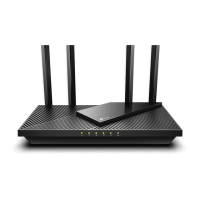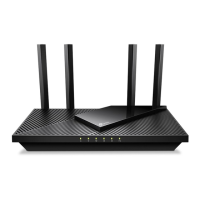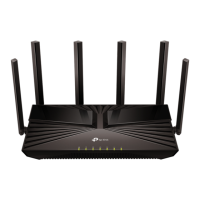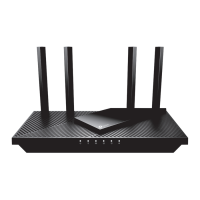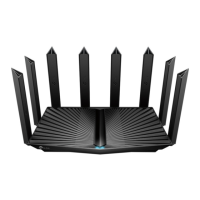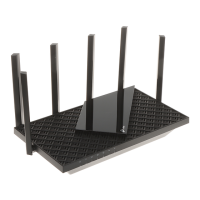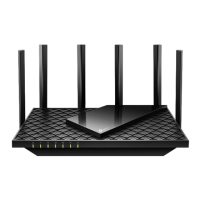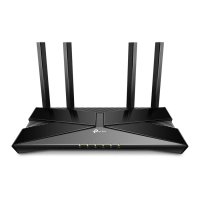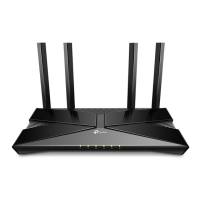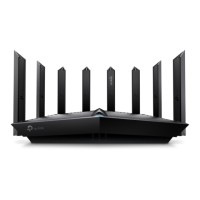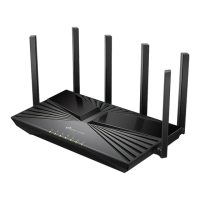Do you have a question about the TP-Link Archer AX55 V1 and is the answer not in the manual?
Details the router's features and Wi-Fi technology for enhanced performance.
Describes the physical appearance of the router and its LED indicators.
Provides guidelines on where to place the router for optimal performance and safety.
Step-by-step instructions for connecting the router to your modem and power source.
Guide on accessing the router's web management interface for configuration.
Guides users through an automated process to configure the internet connection.
Instructions for setting up the router using the mobile TP-Link Tether app.
Detailed steps for manually configuring various internet connection types.
Instructions to configure the router to extend an existing wired network wirelessly.
Steps for configuring an IPv6 internet connection based on ISP requirements.
Explains how to create a TP-Link ID for managing the router via cloud services.
Details on how to update email address and password associated with a TP-Link ID.
Covers adding and removing user TP-Link IDs for router management.
Instructions for using the Tether app to manage the router remotely.
Customizing Wi-Fi network name (SSID), password, and security options.
How to automatically turn the wireless network on/off at specific times.
Setting up a secure Wi-Fi connection using the WPS button.
Configuring advanced wireless parameters like WMM, AP Isolation, and Airtime Fairness.
Steps to set up a separate Wi-Fi network for guests.
Configuring permissions for guest network access, like allowing devices to see each other.
How to connect and access USB storage devices locally and remotely.
Enabling media sharing to view content from USB devices on DLNA-supported devices.
Setting up Time Machine backups for Mac computers to a USB storage device.
Utilizing HomeShield features for network protection against attacks and intrusions.
Setting up restrictions on internet access for family members based on time and content.
Tools for analyzing network usage, optimizing performance, and generating reports.
Creating a unified Wi-Fi network with TP-Link extenders for seamless roaming.
Viewing and managing mesh devices and connected clients within the OneMesh network.
Configuring the SPI Firewall to protect the router and network from external threats.
Blocking or allowing specific devices to access the network using blacklists or whitelists.
Binding IP addresses to MAC addresses to prevent ARP spoofing and attacks.
Configuring Application Layer Gateway settings for network protocols.
Configuring port forwarding to make local services accessible via the internet.
Dynamically opening ports for specific applications like online games.
Setting up a DMZ host to bypass port restrictions for applications.
Enabling UPnP to automatically open ports for gaming and real-time communication.
Setting up an OpenVPN server for secure remote access to the home network.
Configuring a PPTP VPN server for remote access, easier to use but less secure.
Modifying the router's LAN IP address and subnet mask.
Setting up the router for IPTV services, including IGMP proxy configuration.
Configuring the DHCP server, IP address pool, and address reservation.
Setting up a DDNS service to access the router using a domain name.
Manually configuring routing entries to direct network traffic.
Instructions for updating the router's firmware via auto-update or manual download.
Backing up and restoring router configuration settings, and factory reset.
Changing the password used to log into the router's web management page.
Enabling and configuring the password recovery feature for forgotten login passwords.
Controlling access to the router's management interface based on MAC address.
Configuring access to manage the router remotely over the internet.
Saving and sending system logs for troubleshooting and monitoring router status.
Using diagnostic tools like Ping and Traceroute to test network connectivity.
Configuring the router's system time and interface language.
Scheduling automatic reboots for the router to enhance performance.
Managing the router's LED indicators, including enabling Night Mode.
| Wireless Standard | Wi-Fi 6 (802.11ax) |
|---|---|
| Max Speed | 3000 Mbps |
| USB Port | 1 x USB 3.0 port |
| Antennas | 4 x External Antennas |
| RAM | 256 MB |
| MU-MIMO | Yes |
| OFDMA | Yes |
| Beamforming | Yes |
| Frequency Band | Dual-band |
| WiFi Speeds | 574 Mbps (2.4 GHz) + 2402 Mbps (5 GHz) |
| Ports | 4 x Gigabit LAN |
| Security | WPA3 |
| Working Modes | Router, Access Point |
| Dimensions | 260.2 x 135.0 x 41.6 mm (10.2 x 5.3 x 1.6 in) |
